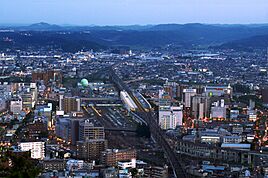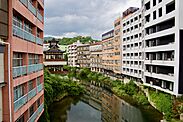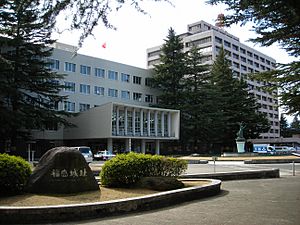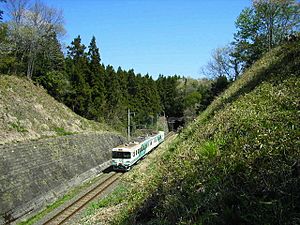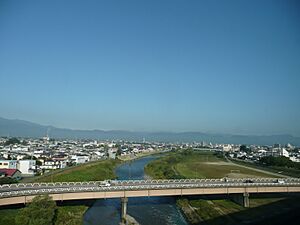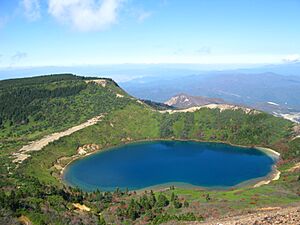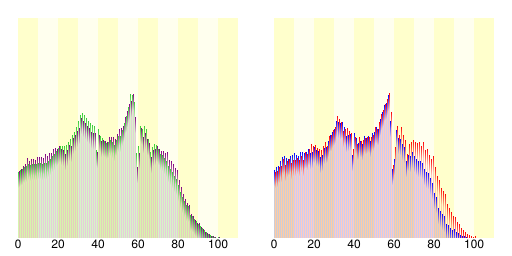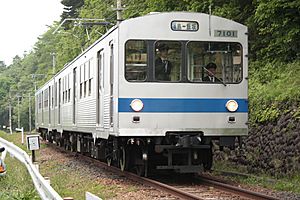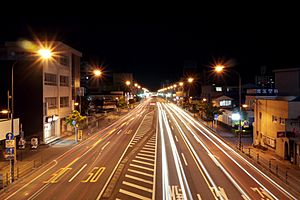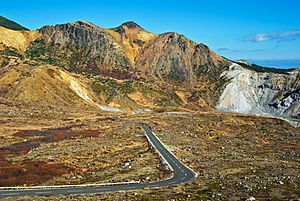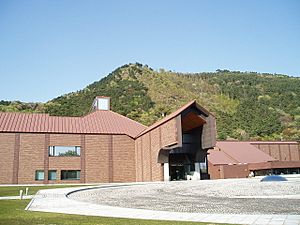Fukushima (city) facts for kids
Quick facts for kids
Fukushima
福島市
|
|||
|---|---|---|---|
|
Counter clockwise from top left: Night view looking towards Fukushima Station, Iizaka Onsen, Hanamiyama Park during cherry blossom season, Fukushima Racecourse, and Mount Shinobu
|
|||
|
|||
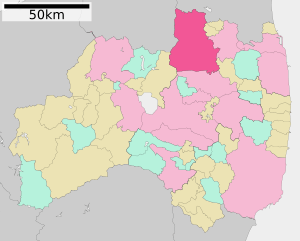
Location of Fukushima in Fukushima Prefecture
|
|||
| Country | Japan | ||
| Region | Tōhoku | ||
| Prefecture | Fukushima | ||
| Area | |||
| • Total | 767.72 km2 (296.42 sq mi) | ||
| Elevation | 67 m (220 ft) | ||
| Population
(August 1, 2023)
|
|||
| • Total | 275,850 | ||
| • Density | 359.311/km2 (930.610/sq mi) | ||
| Time zone | UTC+9 (Japan Standard Time) | ||
| - Tree | Zelkova serrata | ||
| - Flower | Peach | ||
| - Bird | Great tit | ||
| Phone number | 024-535-1111 | ||
| Address | 3-1 Gorōuchimachi, Fukushima-shi, Fukushima-ken 960–8601 | ||
Fukushima is a major city in Japan. It is the capital city of Fukushima Prefecture. The city is in the northern part of the prefecture. As of August 2023, about 275,850 people live there. The total area of Fukushima is about 767.72 square kilometers.
Fukushima is known for its many onsen (hot springs). These include Iizaka Onsen, Takayu Onsen, and Tsuchiyu Onsen. It also has the Fukushima Race Course. This is the only horse racing track in the Tōhoku region of Japan.
Contents
Fukushima's Past: A Look at History
Early Times in Fukushima
Long ago, the area of Fukushima City was called Minekoshi. The mountain in the city, now called Mt. Shinobu, was also once known as Mt. Minekoshi. During the Jōmon period, about 2,000 years ago, a large village existed by the Abukuma River. This ancient site is called the Miyahata Site.
In the 5th century AD, a leader named Kumano Atai was put in charge of the Fukushima Basin. This was done by the ancient Yamato court. Later, during the Nara period, travel stops were set up for officials. One stop, Minekoshi Station, was on a route through what is now Fukushima.
The area of Fukushima and Date became a district called Shinobu. This was the northern border of the Mutsu Province. It was important for protecting against the Emishi people in the north. Over time, the area's name changed from Minekoshi to Suginome. This showed that political power was now centered there.
From Castles to New Names
In 1413, a castle called Daibutsu Castle was first mentioned in history. It was also known as Suginome Castle. This castle was where the Abukuma and Arakawa rivers meet. Today, the Fukushima Prefectural Offices are located there.
Later, in 1592, a leader named Kimura Yoshikiyo moved into Suginome Castle. He changed its name to Fukushima-jō, meaning "Lucky Island Castle." This is how the city got its current name. Like many old castles in Japan, Fukushima Castle was later taken down.
In 1600, a battle called the Battle of Matsukawa happened near Fukushima. The Matsukawa River flowed differently back then. The battle took place in what is now the center of Fukushima. In 1664, the area came under the direct rule of the Tokugawa shogunate. In 1702, the Fukushima Domain was created and ruled from Fukushima Castle.
Fukushima in the 1800s
In 1868, the Fukushima Domain surrendered. The area then became part of the first Fukushima Prefecture in 1871. On September 10, 1871, the village of Fukushima officially became the town of Fukushima.
Later, in November 1871, Fukushima Prefecture was absorbed into Nihonmatsu Prefecture. But soon after, Nihonmatsu Prefecture was renamed Fukushima Prefecture. Fukushima City was chosen as the capital. In 1876, Fukushima Prefecture merged with other areas to form the present-day Fukushima Prefecture. Fukushima remained the capital.
Important transportation links were built in the late 1800s. In 1881, National Route 13 opened, connecting Fukushima to Yonezawa. In 1887, the Tōhoku Main Line railway opened. This brought Fukushima Station to the city. In 1899, Fukushima was linked to Yonezawa by the Ōu Main Line railway. Also in 1899, the Bank of Japan opened its first branch in the Tōhoku region here.
Modern Fukushima's Growth
On April 1, 1907, the town of Fukushima officially became the City of Fukushima. It was the second city in the prefecture. At that time, about 30,000 people lived in Fukushima.
In 1908, a light rail system opened, connecting Fukushima to Yuno. The Fukushima Race Course held its first horse race in 1918. In 1924, the Iizaka Line electric tramway started service. This line connected Fukushima Station to Iizaka.
In 1937, parts of nearby villages joined Fukushima. In 1941, NHK opened its first broadcast station in the city. Towards the end of World War II, on July 20, 1945, a United States bomber dropped bombs on the Watari area.
After World War II
After the war, Fukushima continued to grow. In 1947, Fukushima Medical University was established. In 1948, a train derailed near Niwasaka Station, causing three deaths. The next year, in 1949, another train derailment happened near Matsukawa, also killing three crew members. These events were investigated. Also in 1949, Fukushima University opened.
A new city hall was built in 1952. In 1959, NHK started television broadcasts. The Bandai-Azuma Skyline tourist road opened in 1959.
The first Waraji Festival was held on August 1, 1970. In this festival, people parade a huge straw sandal through the streets. In 1975, the Tōhoku Expressway opened, linking Fukushima to other cities. The Tōhoku Shinkansen (bullet train) opened in 1982, connecting Fukushima to major cities like Ōmiya and Morioka.
In 1986, the Abukuma River flooded due to a typhoon. This caused damage to many buildings. The Abukuma Express Line railway began operations in 1988. This line connects Fukushima to Marumori in the north. The Yūji Koseki Memorial Museum also opened in 1988.
In 1992, the Yamagata Shinkansen opened, connecting Fukushima to Yamagata. In 1995, Fukushima hosted the 50th National Sports Festival of Japan.
Fukushima Since 2000
The Surikamigawa Dam was completed in 2005. In 2007, Fukushima celebrated its 100th anniversary as a city. A special festival with parade floats (dashi) was held. In 2008, the town of Iino became part of Fukushima.
A new city hall opened in Fukushima on January 4, 2011. On March 11, 2011, the 2011 Tōhoku earthquake and tsunami hit. The earthquake damaged water pipes, causing many parts of the city to lose water. Train services were also stopped but slowly reopened over the next few weeks. On April 1, 2018, Fukushima City became a core city.
Fukushima's Location and Landscape
 |
Yonezawa | Koori | Date |  |
| Mt. Azuma | Sōma | |||
| Mt. Adatara | Nihonmatsu | Kawamata |
Fukushima is in the central northeast part of Fukushima Prefecture. It is about 250 kilometers north of Tokyo. The city sits between the Ōu Mountains to the west and the Abukuma Highlands to the east. Most of Fukushima is in the Fukushima Basin. Mt. Azuma and Mt. Adatara are large mountains to the west and southwest.
Fukushima borders cities in Miyagi Prefecture and Yamagata Prefecture. Within Fukushima Prefecture, it is next to Nihonmatsu to the south. To the east are Kawamata and Date. To the north is Koori.
Understanding Fukushima's Terrain
The Fukushima Basin is surrounded by mountains. The Abukuma River flows through the middle of the basin from south to north. Many smaller rivers flow from the Ōu Mountains into the Abukuma River. These include the Surikami, Matsukawa, and Arakawa rivers. These rivers helped grow mulberry trees in the past. Now, they help irrigate many fruit orchards.
The highest point in Fukushima City is Mt. Higashi-Azuma, which is 1,974 meters tall. The lowest point is 55 meters above sea level. Mt. Shinobu, a 276-meter tall mountain, is a symbol of the city.
The Abukuma River is the main river. The Arakawa River and Matsukawa River flow into it. The Surikami River also joins the Abukuma River. It flows from near the Fukushima-Yamagata border. It goes into Lake Moniwa, a reservoir created by the Surikamigawa Dam.
There are several lakes in the area. Goshiki-numa, also called "The Witch's Eye," is a lake on Mt. Azuma. Its water color changes with the weather. Lake Kama and Lake Oke are also in the Bandai-Asahi National Park. Other small lakes include Lake Me, Lake O, and Lake Nida.
Fukushima's Climate and Weather
Fukushima has a humid subtropical climate. This means it has hot, humid summers and mild winters. The weather can be very different between the city center and the mountains. August is usually the hottest month. The average high in central Fukushima is 30.4°C. In the mountains, it's cooler, around 21.7°C. January is the coldest month. The average low in the city is -1.8°C, and in the mountains, it's -9.0°C.
Fukushima gets about 1,166 millimeters of rain each year. It snows about 189 centimeters annually, with January being the snowiest month. The city center gets more sunshine than the mountain areas.
| Climate data for Fukushima (1991−2020 normals, extremes 1889−present) | |||||||||||||
|---|---|---|---|---|---|---|---|---|---|---|---|---|---|
| Month | Jan | Feb | Mar | Apr | May | Jun | Jul | Aug | Sep | Oct | Nov | Dec | Year |
| Record high °C (°F) | 18.1 (64.6) |
21.4 (70.5) |
25.2 (77.4) |
32.2 (90.0) |
35.3 (95.5) |
36.7 (98.1) |
39.0 (102.2) |
39.1 (102.4) |
37.3 (99.1) |
30.3 (86.5) |
26.0 (78.8) |
22.4 (72.3) |
39.1 (102.4) |
| Mean daily maximum °C (°F) | 5.8 (42.4) |
7.1 (44.8) |
11.2 (52.2) |
17.7 (63.9) |
23.1 (73.6) |
25.9 (78.6) |
29.1 (84.4) |
30.5 (86.9) |
26.2 (79.2) |
20.5 (68.9) |
14.5 (58.1) |
8.6 (47.5) |
18.3 (64.9) |
| Daily mean °C (°F) | 1.9 (35.4) |
2.5 (36.5) |
5.9 (42.6) |
11.7 (53.1) |
17.2 (63.0) |
20.7 (69.3) |
24.3 (75.7) |
25.5 (77.9) |
21.6 (70.9) |
15.6 (60.1) |
9.5 (49.1) |
4.3 (39.7) |
13.4 (56.1) |
| Mean daily minimum °C (°F) | −1.5 (29.3) |
−1.2 (29.8) |
1.3 (34.3) |
6.4 (43.5) |
12.1 (53.8) |
16.6 (61.9) |
20.8 (69.4) |
21.9 (71.4) |
18.0 (64.4) |
11.7 (53.1) |
5.2 (41.4) |
0.7 (33.3) |
9.3 (48.7) |
| Record low °C (°F) | −15.0 (5.0) |
−18.5 (−1.3) |
−12.9 (8.8) |
−5.5 (22.1) |
−1.2 (29.8) |
3.8 (38.8) |
9.1 (48.4) |
9.8 (49.6) |
4.8 (40.6) |
−1.7 (28.9) |
−6.6 (20.1) |
−13.5 (7.7) |
−18.5 (−1.3) |
| Average precipitation mm (inches) | 56.2 (2.21) |
41.1 (1.62) |
75.7 (2.98) |
81.8 (3.22) |
88.5 (3.48) |
121.2 (4.77) |
177.7 (7.00) |
151.3 (5.96) |
167.6 (6.60) |
138.7 (5.46) |
58.4 (2.30) |
48.9 (1.93) |
1,207 (47.52) |
| Average snowfall cm (inches) | 49 (19) |
34 (13) |
14 (5.5) |
1 (0.4) |
0 (0) |
0 (0) |
0 (0) |
0 (0) |
0 (0) |
0 (0) |
1 (0.4) |
24 (9.4) |
122 (48) |
| Average precipitation days (≥ 0.5 mm) | 10.6 | 8.6 | 9.2 | 8.2 | 9.7 | 11.9 | 15.2 | 12.4 | 12.0 | 9.7 | 7.7 | 10.8 | 126.0 |
| Average relative humidity (%) | 68 | 65 | 61 | 58 | 63 | 72 | 77 | 76 | 76 | 73 | 70 | 70 | 69 |
| Mean monthly sunshine hours | 132.2 | 144.8 | 175.1 | 189.7 | 193.2 | 141.4 | 125.2 | 148.7 | 122.9 | 133.7 | 128.3 | 118.7 | 1,753.8 |
| Source: Japan Meteorological Agency | |||||||||||||
Who Lives in Fukushima?
Fukushima has the third-largest population in its prefecture. It is behind Iwaki and Kōriyama. This makes Fukushima the only prefectural capital in Japan that is not the largest or second-largest city in its prefecture.
Fukushima's Economy: How People Make a Living
In 2005, the total income for all people in Fukushima was about 1.108 trillion Japanese Yen. Most of this income came from the service industry.
Fukushima's Farming and Fruits
Farming is a big part of Fukushima's economy. Most of the money from farming comes from growing crops. Fruits make up 60% of the crop value. Rice and vegetables are also important.
Fukushima is famous for its fruits! It produces many apples, Japanese pears, and peaches. In 2010, Fukushima produced 8.2% of all peaches grown in Japan. The city is sometimes called the "Fruit Kingdom" because of its many fruit orchards. You can find these orchards along the "Fruit Line" road.
Industries and Businesses in Fukushima
In 2009, Fukushima's industries employed over 18,000 workers. They shipped goods worth 671 billion Japanese Yen. Information-related industries made up the largest part of this. Other important industries include food, metals, and chemicals.
Several company headquarters are in Fukushima. These include Toho Bank, Fukushima Bank, and Daiyu Eight.
Getting Around Fukushima: Transportation
Fukushima has always been an important place for travel. It is where major roads and train lines meet.
Train Travel in Fukushima
You can travel by train on the Tōhoku Shinkansen and Yamagata Shinkansen bullet trains. JR East also runs local services. These include the Tōhoku Main Line and Ōu Main Line. Fukushima Station is a key hub.
Other train lines are the Iizaka Line and the Abukuma Express Line. The Iizaka Line connects the city center to Iizaka. The Abukuma Express Line follows the Abukuma River. It connects Fukushima to Miyagi Prefecture in the north.
 East Japan Railway Company (JR East) - Tōhoku Shinkansen / Yamagata Shinkansen
East Japan Railway Company (JR East) - Tōhoku Shinkansen / Yamagata Shinkansen
- Station in the city: Fukushima
 JR East - Tohoku Main Line
JR East - Tohoku Main Line
- Matsukawa - Kanayagawa - Minami-Fukushima - Fukushima - Higashi-Fukushima
 JR East - Ōu Main Line (Yamagata Line)
JR East - Ōu Main Line (Yamagata Line)
- Fukushima - Sasakino- Niwasaka - Akaiwa
- AbukumaExpress - Abukuma Express Line
- Fukushima - Oroshimachi - Fukushima Gakuin-mae - Senoue - Mukaisenoue
- Fukushima Transportation - Iizaka Line
- Fukushima - Soneda - Bijutsukantoshokanmae - Iwashiroshimizu - Izumi - Kamimatsukawa -Sasaya - Sakuramizu - Hirano - Iohji-mae - Hanamizuzaka - Iizaka Onsen
Roads and Highways
For cars, the Tōhoku Expressway passes through Fukushima. It connects Tokyo in the south to Aomori in the north. Six national highways also run through Fukushima. Japan National Route 4 goes to Tokyo and Sendai. Japan National Route 13 starts in Fukushima and goes through Yamagata Prefecture.
 Tōhoku Expressway
Tōhoku Expressway Tōhoku-Chūō Expressway
Tōhoku-Chūō Expressway National Route 4
National Route 4 National Route 13
National Route 13 National Route 114
National Route 114 National Route 115
National Route 115 National Route 399
National Route 399 National Route 459
National Route 459
The Bandai-Azuma Skyline is a scenic road. It goes up and along Mt. Azuma. This road connects Takayu Onsen and Tsuchiyu Onsen. Local bus services are mainly run by Fukushima Transportation. You can also take intercity buses to other cities in Japan.
Airports Near Fukushima
Fukushima City does not have its own commercial airport. For air travel, people use Fukushima Airport in Sukagawa. They also use Sendai Airport in Natori, Miyagi.
Learning and Culture in Fukushima
Fukushima has many places for learning and culture. These include libraries, museums, and schools.
Museums in Fukushima include the Yūji Koseki Memorial Museum. There is also the Fukushima City Museum of Photography. The Fukushima Prefectural Museum of Art is located near Bijutsukantoshokanmae Station. This museum has about 2,200 artworks. These include French Impressionist paintings and Japanese modern art.
Fukushima operates 19 libraries and library branches. The Fukushima Prefectural Library is also in the city. It is next to the Prefectural Museum of Art.
For higher education, Fukushima has several colleges and universities. These include Fukushima University, Fukushima Medical University, and Fukushima College.
Sports in Fukushima
Fukushima is home to the Fukushima Azuma Baseball Stadium. This stadium was used for the 2020 Summer Olympics in Tokyo. The city also has a professional football (soccer) team, Fukushima United. They play at the Toho Stadium. The city's professional basketball team is the Fukushima Firebonds. They play in the Japanese Second Division.
Images for kids
See also
 In Spanish: Fukushima (Fukushima) para niños
In Spanish: Fukushima (Fukushima) para niños


